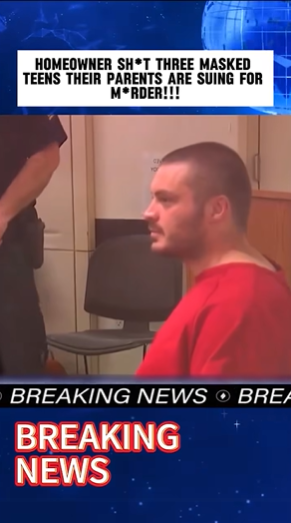A recent case involving a homeowner and a group of teenagers has gained national attention, raising important questions about self-defense, property rights, and legal accountability. The incident, which ended tragically, has now resulted in a lawsuit filed by the parents of the teenagers, drawing strong reactions from both legal experts and the public.
The Incident
According to multiple reports, the situation began late one evening when three teenagers, reportedly wearing masks, entered a homeowner’s property. The exact nature of their intentions remains unclear. Some accounts suggest they may have been attempting to trespass or cause damage, while others indicate the possibility that they were simply exploring the area.
The homeowner, believing there was a potential threat, responded with force. Emergency responders arrived quickly, but the teens did not survive the encounter. The sudden loss of life shocked neighbors and immediately sparked widespread discussion about what had happened and how it could have been prevented.
Parents’ Legal Action
Following the tragedy, the families of the teenagers filed a lawsuit against the homeowner. They argue that the use of deadly force was unnecessary and excessive, particularly given that their children were minors. Their legal claim seeks accountability, emotional restitution, and recognition that even in cases of trespassing, young people are still entitled to legal protection.
Legal analysts note that civil suits of this nature are highly complex. While criminal charges may or may not be filed depending on the findings of the investigation, civil litigation allows families to pursue damages and test the boundaries of self-defense laws in a courtroom setting.
The Legal Context
At the heart of the case are long-standing legal doctrines related to self-defense. In many states, laws such as the Castle Doctrine or Stand Your Ground statutes allow homeowners to use force when they believe they are in imminent danger. However, experts emphasize that these protections are not unlimited. Courts must weigh factors such as the age of those involved, whether the homeowner’s fear was reasonable, and if the response matched the level of perceived threat.
This case is further complicated by the fact that minors were involved, which often influences how juries and judges view the proportionality of a homeowner’s actions.
Broader Ethical Questions
Beyond legal frameworks, the situation has raised ethical and social debates. Critics argue that using deadly force against teenagers without attempting alternative responses, such as contacting law enforcement, sets a troubling precedent. Supporters, however, believe homeowners must be able to protect themselves when faced with masked intruders, as uncertainty about intentions can create real fear.
The community remains divided—some residents express empathy for the homeowner, citing safety concerns, while others stress the importance of preserving young lives and finding non-lethal methods of conflict resolution.
Law Enforcement Investigation
Authorities continue to investigate the incident, reviewing surveillance footage, gathering witness testimony, and analyzing evidence to determine whether the homeowner acted within legal boundaries. Investigators are also considering the history of the neighborhood, including prior trespassing or break-in attempts, which could influence perceptions of the homeowner’s response.
Wider Legal and Social Implications
Cases like this are not new, but each one shapes ongoing discussions about the balance between personal safety and responsible action. Previous rulings in similar situations have produced varied results, with some courts siding fully with homeowners and others limiting the use of deadly force.
Even if no criminal charges are filed, the civil lawsuit ensures the case will remain in the spotlight. Outcomes could include financial penalties, settlements, or rulings that further define the responsibilities of property owners when dealing with perceived threats.
Community and Emotional Impact
For the families of the teenagers, the lawsuit is not only about legal accountability but also about mourning their loss and seeking recognition of the harm they have endured. Meanwhile, the wider community is left grappling with difficult questions about safety, responsibility, and the role of firearms in residential areas.
Local meetings and online discussions continue to reflect the split in opinion, with some calling for stronger community safety measures and others emphasizing the importance of protecting property rights.
Media and Public Reaction
The case has drawn significant coverage in traditional and social media. News outlets have highlighted the legal debates, while opinion pieces have examined the moral dimensions. On social platforms, the conversation has become even more polarized, with users expressing strong views both in support of and against the homeowner’s actions.
Conclusion
The ongoing lawsuit represents more than a single neighborhood conflict—it reflects broader national debates about self-defense, property rights, and ethical responsibility. As courts work to determine legal accountability, the case will likely influence future interpretations of self-defense laws and spark continued dialogue about the balance between protecting one’s home and preserving human life.
Regardless of the outcome, the incident serves as a sobering reminder of the weight of decisions made in moments of fear, and the lasting consequences those choices can carry for families, communities, and society at large.



